North Carolina is known for its beautiful habitats – its rugged mountain ranges, miles of coastlines, and a diverse network of rivers and streams. Just as diverse are its animals, which are widespread across the state in every single habitat. Amongst these animals are snakes, and there are 37 species – including six that are venomous. Many folks are just plain scared of all snakes, and would enjoy living in a snake-free state. It’s important to understand that non-poisonous snakes in NC, and anywhere for that matter, play an important role in nature by keeping the rodent populations under control. While some of these snakes are rare and endangered, others are particularly abundant. Join us as we discover some of the most common and non-venomous snakes in North Carolina!
Rough Earth Snake
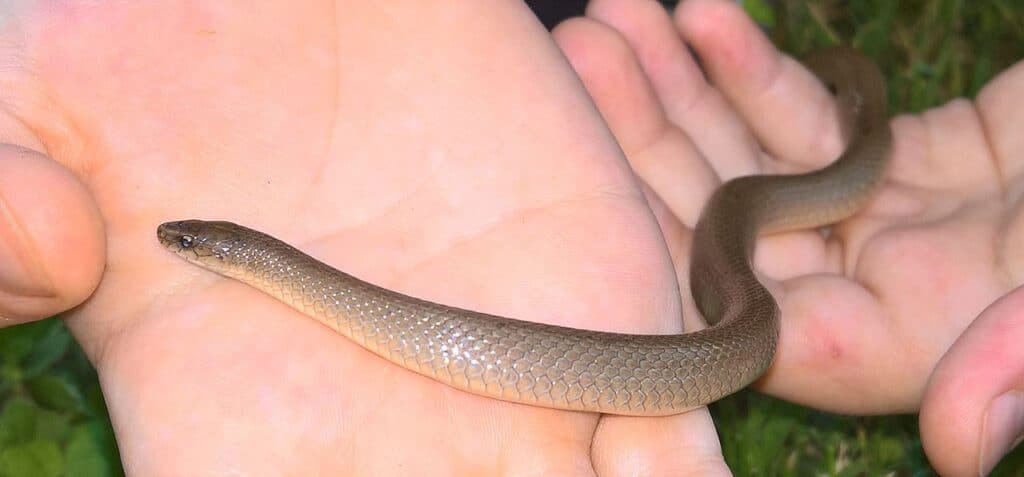
Rough earth snakes are typically brown with white or yellowish bellies.
©Kyle Wiering / Creative Commons – License
The first of the non-poisonous snakes in NC is also one of the smallest at only 7 to 10 inches long. Rough earth snakes are brown with lighter bellies and have slender bodies with keeled scales down their back. These scales create a ridge and give them a rough texture. Although they also live in forests, rough earth snakes are one of the most common snakes in urban areas. They often live in gardens and parks where they can burrow into the soil or hide in the leaf litter. Rough earth snakes are viviparous and give birth to live young, which are only around 4 inches long and look similar to ring-necked snakes. This is because juveniles have a white ring around their neck which fades as they get older.
Eastern Milk Snake
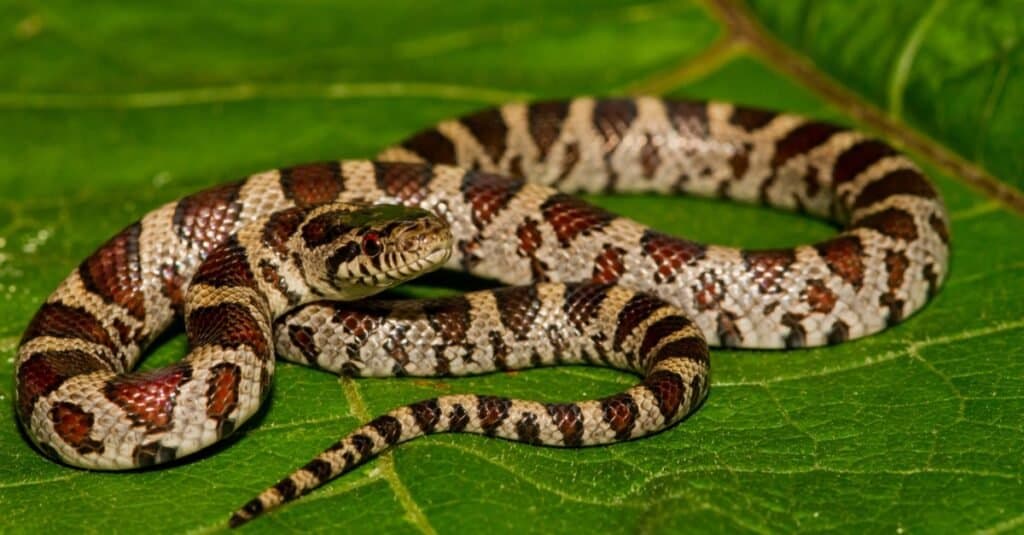
Eastern milk snakes hunt down small rodents often found on farm buildings and barns.
©Jay Ondreicka/Shutterstock.com
As one of 24 subspecies of milk snakes, eastern milk snakes are 2 to 3 feet long and have a stunning appearance. Eastern milk snakes have bright, shiny scales and are usually tan with brown blotches that are bordered with black. They get their name from the myth that claims they stole milk from cows in barns, although this is untrue. Eastern milk snakes usually live in fields, grasslands, and rocky slopes. They are primarily nocturnal and spend their days resting. Eastern milk snakes are not aggressive but will sometimes strike when cornered. They are opportunistic hunters and prey on a range of mammals, birds, lizards, and other snakes.
Mole Kingsnake

Mole kingsnakes have the ability to consume large prey.
©Krumpelman Photography/Shutterstock.com
Although secretive, mole kingsnakes are one of the most common non-poisonous snakes in North Carolina, particularly in the Piedmont region. They are 30 to 42 inches long and are usually light brown with reddish-brown spots, which fade as the snake ages. Mole kingsnakes typically live in areas with plenty of loose, sandy soil for them to burrow into – usually in fields near forest edges. They are oviparous and lay their eggs either under logs or underground. They are not particularly aggressive snakes but tend to vibrate their tail as a warning when disturbed. Mole kingsnakes mainly prey on rodents which are swallowed head first. They are known for their ability to consume large prey that is almost as wide as their own head.
Eastern Worm Snake

Worm Snakes typically have dark tops and lighter-colored undersides.
©Jason Patrick Ross/Shutterstock.com
Another secretive but common snake is the eastern worm snake which is a subspecies of the worm snake. Eastern worm snakes are small, brown snakes that are 7.5 to 11 inches long. They prefer moist woodland regions and areas near wetlands where they can hide underneath logs. Eastern worm snakes are particularly abundant in the Piedmont region, while slightly less in the mountains and coastal plain. Their diet mainly consists of earthworms and other small insects. As they are so small, eastern worm snakes have many predators, especially other snakes and birds.
Southern Black Racer
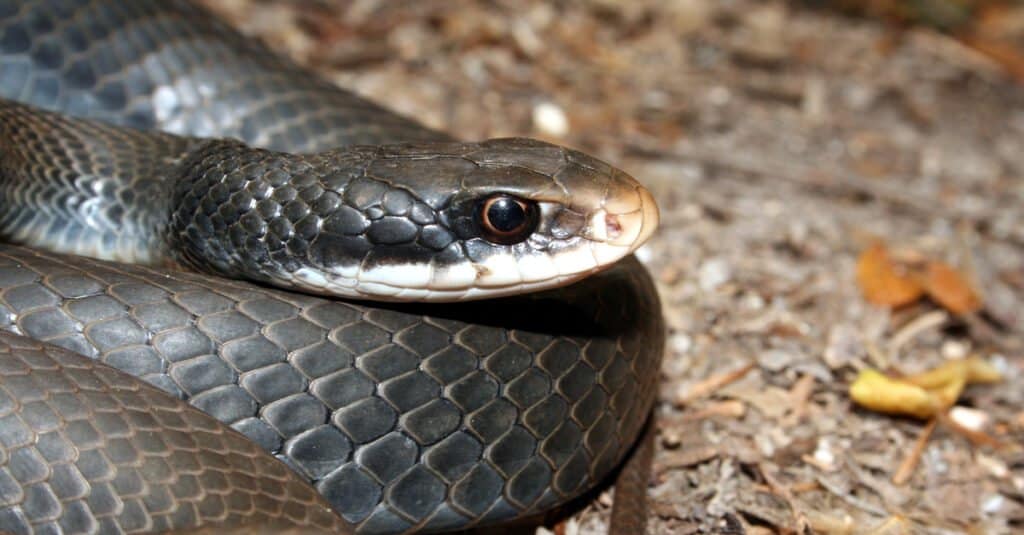
Southern black racer snakes can measure up to 5 feet in length.
©Psychotic Nature/Shutterstock.com
Quite possibly, the most active and agile of non-poisonous snakes in NC is the southern black racer. Southern black racers are one of eleven subspecies of eastern racer snakes, and they live in a wide range of habitats, although open grasslands are preferred. They are 2 to 5 feet long and are usually black with a white chin. Southern black racers use their keen eyesight and speed when hunting, and they prey on a wide range of birds, rodents, lizards, and amphibians. Despite their scientific name (Coluber constrictor), they don’t kill by constriction, preferring instead to beat their prey onto the ground before consuming it.
Corn Snake
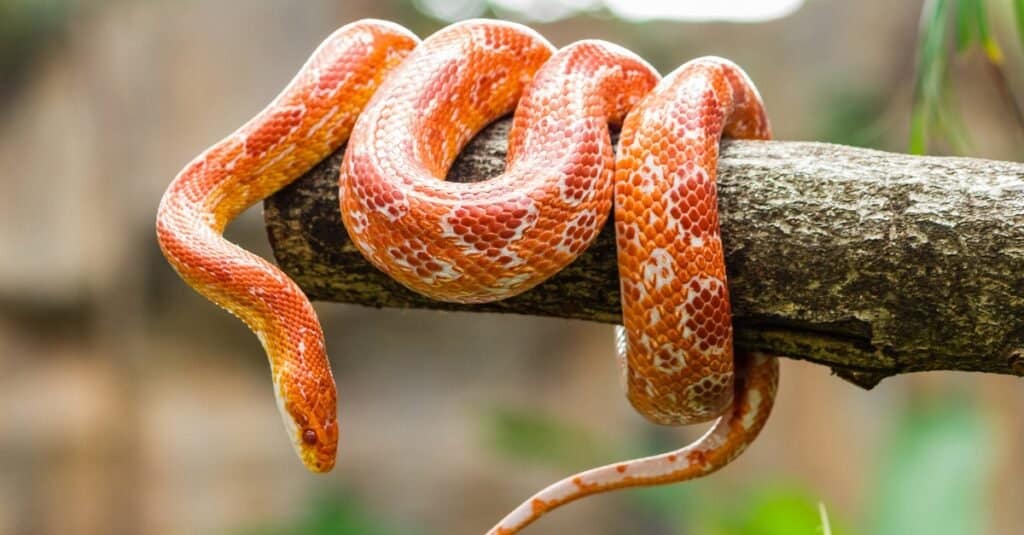
Corn snakes are harmless snakes that are popular as pets.
©iStock.com/bugphai
Easily one of the most common snakes in North Carolina is the corn snake which is also popular as a pet. Corn snakes live in a wide range of habitats – including fields, forest openings, and abandoned farms – and in North Carolina, they are particularly abundant across the southeast coastal plain. They are 3 to 4 feet long and have a distinctive appearance. They are brown or orange with large red blotches on their bodies. Corn snakes are particularly important as they help to keep rodent populations in check which would otherwise damage crops. They actually earned their name from their continued presence around corn sheds where there are high numbers of rodents.
Northern Water Snake
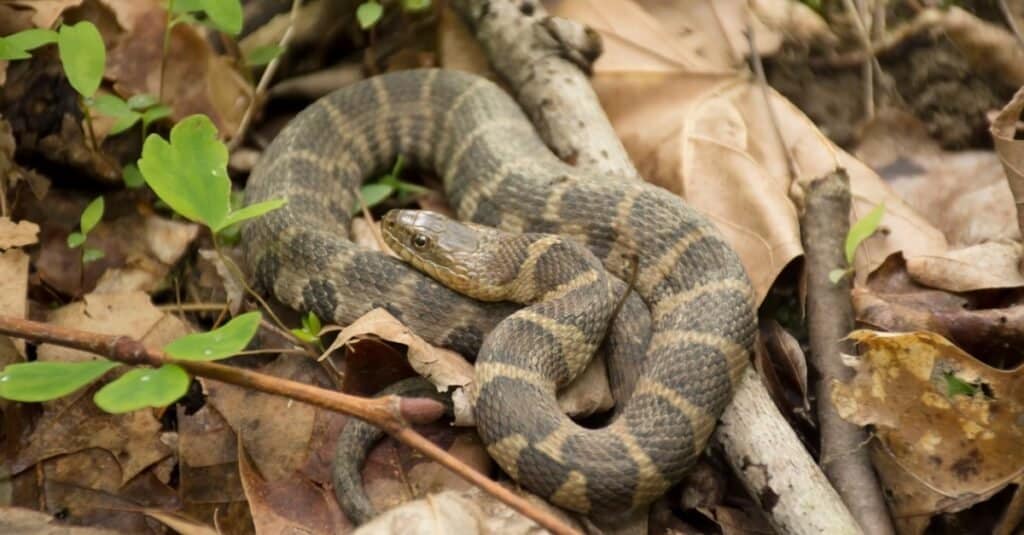
The northern water snake has a flat head that is as wide as its neck.
©iStock.com/IcemanJ
The first of two water snakes on the list of non-venomous snakes in North Carolina is the northern water snake which reaches almost 4.5 feet long. Northern water snakes are brown with dark crossbands on their neck and blotches on their bodies. There are four recognized subspecies – including the Carolina water snake. Northern water snakes live in permanent water sources – such as streams, ponds, and swamps – and are common everywhere in the state except for the southeast coastal plain. Northern water snakes spend their days basking on logs and rocks and their nights hunting in the shallows, where they prey on fish, frogs, birds, and salamanders. Although they are not venomous, they can give a nasty bite, and their saliva contains an anticoagulant which means that wounds bleed more than usual.
Eastern Hognose Snake
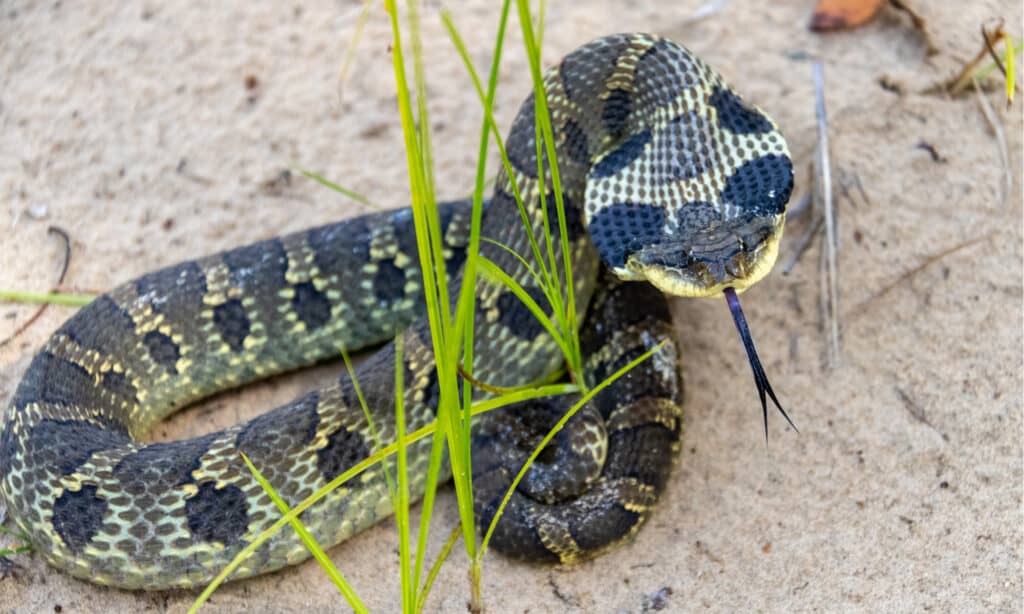
Eastern Hognose Snakes flatten their necks like cobras when threatened.
©IHX/Shutterstock.com
Also known as spreading adders, eastern hognose snakes are mildly venomous to their prey but are considered non-venomous towards humans. Eastern hognose snakes are around 28 inches long and have a noticeably upturned snout. Their color varies, and they can be black, brown, gray, orange, or green with and without blotches. Eastern hognose snakes usually live in woodlands, fields, and coastal regions where there is loose soil that they can burrow into. When they are threatened, they flatten their neck and hiss with their head raised from the ground like a cobra in an attempt to deter the predator. However, they rarely actually bite. Eastern hognose snakes prey almost exclusively on amphibians – particularly toads.
Rough Green Snake

The skin of a rough green snake makes it easy for it to climb trees.
©iStock.com/BobMcLeanLLC
Easily one of the most stunning as well as one of the most common non-poisonous snakes in North Carolina is the rough green snake. Rough green snakes are 14 to 33 inches long and are bright green on their dorsal side with yellow bellies. They have keeled scales which give them a rough texture, hence their name. Rough green snakes are particularly abundant around the Piedmont plateau region. Although they live in meadows and woodlands, they are excellent swimmers and are never very far from a permanent water source. They are accomplished climbers and can be found in low vegetation and trees, where they frequently coil themselves around the branches. Rough green snakes are harmless and mainly eat insects and spiders.
Plain-Bellied Water Snake
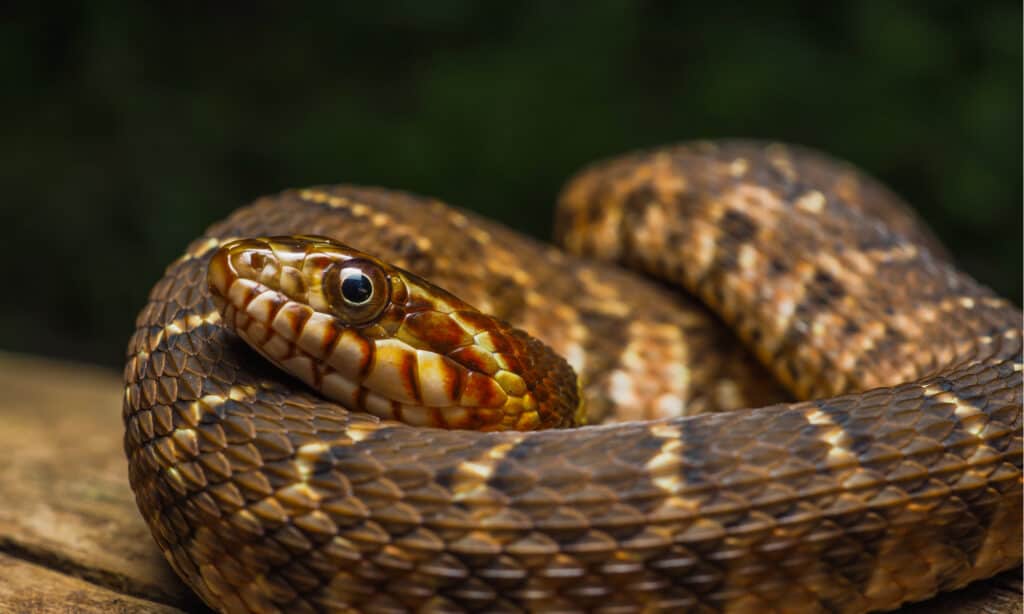
Plain-bellied water snakes spend more time out of the water than other water snakes.
©Tyler Albertson/Shutterstock.com
Another common water snake is the plain-bellied water snake. Plain-bellied water snakes are 24 to 40 inches long and have thick, heavy bodies. They are usually brown, gray, or black with yellow or orange bellies. Plain-bellied water snakes always live near permanent water sources but tend to spend more time out of the water than other true water snakes do. Despite this, they rely on water for their food and eat mainly fish, frogs, and salamanders. Although plain-bellied water snakes usually actively hunt for their prey, they have been observed using ambush tactics too. They are not constrictors, and prey is swallowed alive.
Summary of 10 of the Most Common (and Non-Venomous) Snakes in North Carolina
| Rank | Species | Length | Key Features |
|---|---|---|---|
| 1 | Rough Earth Snake | 7 to 10 inches | A slender form, brown coloring with lighter bellies and keeled dorsal scales |
| 2 | Eastern Milk Snake | 2 to 3 feet | Bright, shiny scales, tan coloring with brown patches fringed with black |
| 3 | Mole Kingsnake | 30 to 42 inches | Light brown coloring with reddish-brown spots |
| 4 | Eastern Worm Snake | 7.5 to 11 inches | A dark brown dorsal surface, a light ventral surface |
| 5 | Southern Black Racer | 2 to 5 feet | Black scales which turn white at the chin |
| 6 | Corn Snake | 3 to 4 feet | Brown or orange coloring with large red patches |
| 7 | Northern Water Snake | About 4.5 feet | Brown with dark crossbands at the neck and blotches on their bodies |
| 8 | Eastern Hognose Snake | About 28 inches | May be black, brown, gray, orange, or green and may or may not be covered in patches |
| 9 | Rough Green Snake | 14 to 33 inches | A bright green keeled scales on the dorsal surface which turn yellow at the belly |
| 10 | Plain-Bellied Water Snake | 24 to 40 inches | Brown, gray, or black scales which turn yellow or orange at the belly |
The photo featured at the top of this post is © iStock.com/bugphai
Discover the "Monster" Snake 5X Bigger than an Anaconda
Every day A-Z Animals sends out some of the most incredible facts in the world from our free newsletter. Want to discover the 10 most beautiful snakes in the world, a "snake island" where you're never more than 3 feet from danger, or a "monster" snake 5X larger than an anaconda? Then sign up right now and you'll start receiving our daily newsletter absolutely free.
Thank you for reading! Have some feedback for us? Contact the AZ Animals editorial team.






